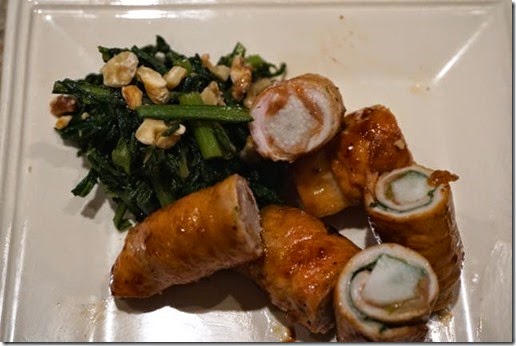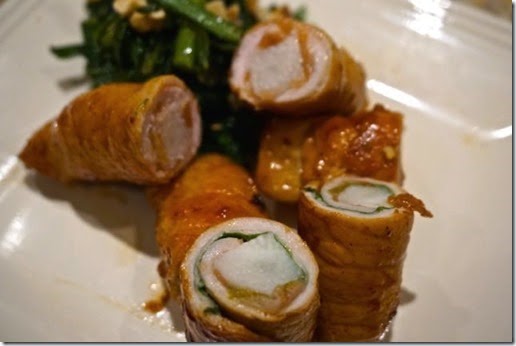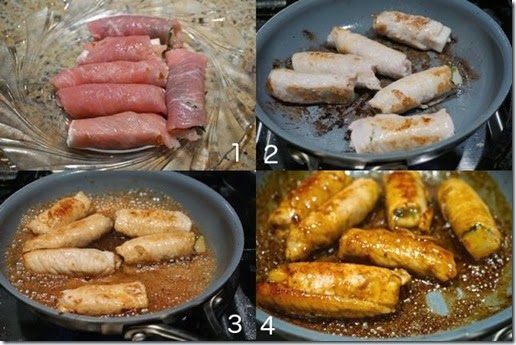We continued with our hanami.
We have mentioned before that, for some reason, the birds (and now other creatures) eat the cherry blossoms from the trees in our backyard. These are ornamental rather than fruit producing cherry trees so we’re not clear why they do this. In addition, we have not heard of similar behavior toward the trees on the Tidal Basin or anywhere else for that matter. It started some time ago with the house finches. Then apparently the cardinals learned from the finches and we have a few pictures here as “proof”. Sometimes it feels like a race to finish our hanami before the birds finish the blossoms we are celebrating. Often the petals are raining down around us at a furious pace as we raise our sake glasses in libation (Occasionally having to pause and fish out petals that plop into the up-raised glasses.)
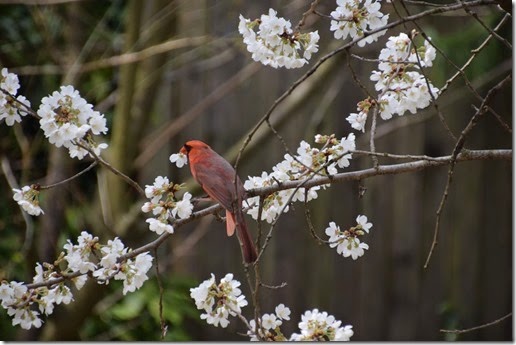
As you can see this one got caught “red beaked” as it were. Come to think of it their beaks are always red.
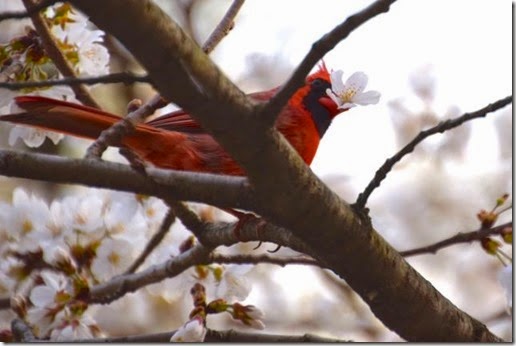
They only eat the bottom of the flowers which must contain a sweet nectar or something.

Amazingly, some of our squirrels appear to have learned from the birds. This is the first year we caught one eating the flower. As a result, even before full bloom, cherry petals were dropping.
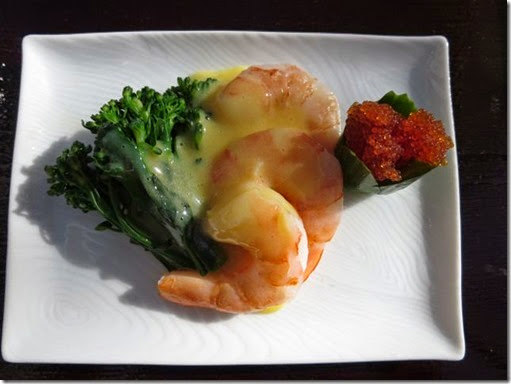
In any case, we continued with our feast despite this distraction. This one is "Nanohana" (broccolini) and shrimp dressed in “kimisu” 菜の花と海老の黄身酢和え. “Kimisu” is a sort of Japanese hollandaise sauce without butter. I also added
cucumber cup with tobiko roe on the side.
I got this idea when Chef Kitayama of
Sushi taro served a dish with “kimisu” the last time we dined there. His was very rich and thick. He said he attained that texture by freezing the eggs in the shell. This makes it easier to completely remove the egg white (after thawing I assume) and also removes extra moisture from the yolk. I, of course, did not take this extra-step. Here is my recipe (the standard recipe but I did not measure the ingredients, the below is my estimate).
“
Kimisu” 黄身酢:
One egg yolk (I used pasteurized shell egg)
Sugar (1 tsp)
Salt (small pinch)
Sake and mirin (1 tsp each)
Rice vinegar (1 tsp)
I mixed everything in a small sauce pan, on the lowest flame. Using a silicon spatula, I continuously mixed until the sauce thickened. I moved the pan on and off the fire to prevent scrambling the eggs. Since I did not remove the chalaza completely from the yolk, it became white hard specks in the sauce. I used a fine mesh strainer to remove it. I placed it in a small sealable container and refrigerated until use.
“
Nanohana” 菜の花: I have
posted information about flowering rapeseed plants and possible substitutes in the U.S. The substitute is between broccolini and broccoli rabe. I used broccolini for this dish. I just blanched it in salted boiling water for a few minutes and shocked it in ice cold water and drained.
Shrimp: These were shell-on frozen shrimp. I thawed them under running water. I rather severely salted it and let it stand for a while. I then cooked them in gently simmering salted water splashed with sake for few minutes, let them cool in the shell and then peeled the shell.
Although the sauce was not as rich or thick as Chef Kitayama's it was rather luxurious with some tang and sweetness gently wrapped in. A perfect, subtle spring dish.
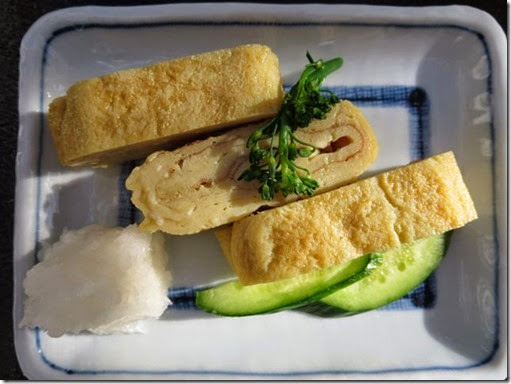
The 3rd dish was usual “
dashi maki” 出し巻き Japanese omelet. I served it with grated daikon and soy sauce on the side.
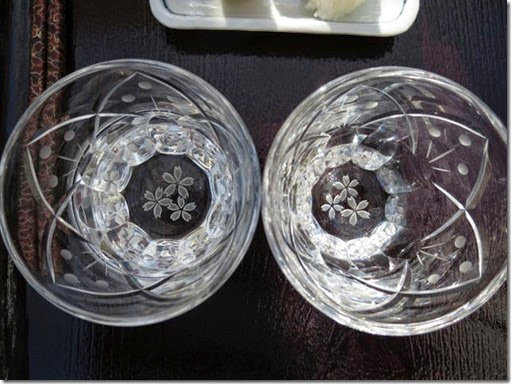
We switched the sake glasses . These came from
Kitaichi glass 北一グラス in Otaru 小樽. Left is with sake in it, the right is without sake. Once the glass is filled with liquid, the cherry blossom pattern around the base appear to float up but it is not easy to capture this in a photograph. In any case, these were more appropriate glasses for the occasion.
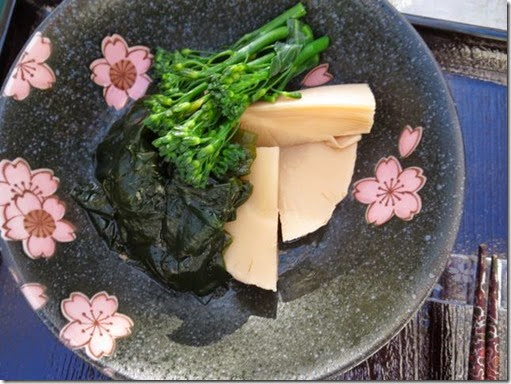
The 4th dish was
Wakatake-ni 若竹煮. Although it is the season for bamboo shoots and fresh wakame seaweed in Japan, we could not get these seasonal items around here. I used packaged boiled bamboo shoot (I am sure from the last year crop) and
salt preserved wakame sea weed (which was kept frozen in the freezer).
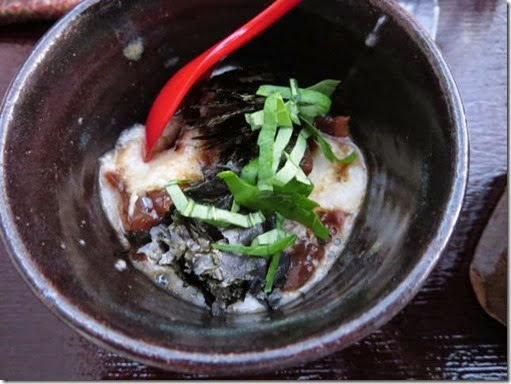
The 5th dish was our usual
yamakake 山掛け (cubes of marinated tuna and graded nagaimo). Since we did not have perilla leaves, I used fresh basil leaves we had growing on the window sill. (I gave my wife the choice of fresh mint or basil leaves. She suggested basil). Unexpectedly, this combination was really good. I think we’ll use it again.
Although these were small dishes, we are getting quite filled up at this point. Since the day was so warm, we turned on the flood lights and went into night time cherry blossom gazing or “
yozakura kenbutsu” 夜桜見物.
